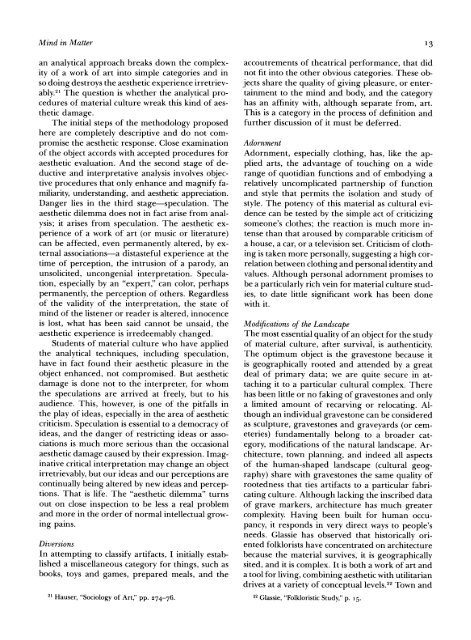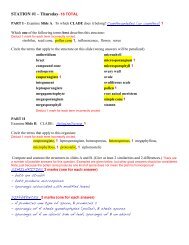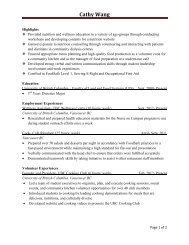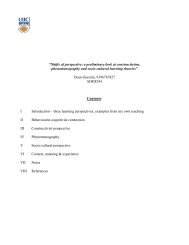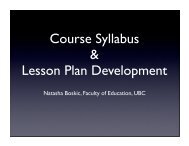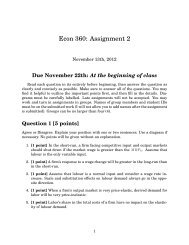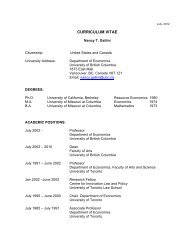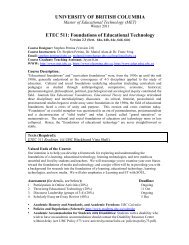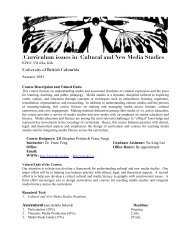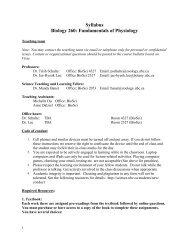<strong>M<strong>in</strong>d</strong> <strong>in</strong> <strong>Matter</strong>an analytical approach breaks down the complexityof a work of art <strong>in</strong><strong>to</strong> simple categories and <strong>in</strong>so do<strong>in</strong>g destroys the aesthetic experience irretrievably.21The question is whether the analytical proceduresof material culture wreak this k<strong>in</strong>d of aestheticdamage.The <strong>in</strong>itial steps of the methodology proposedhere are completely descriptive and do not compromisethe aesthetic response. Close exam<strong>in</strong>ationof the object accords with accepted procedures foraesthetic evaluation. <strong>An</strong>d the second stage of deductiveand <strong>in</strong>terpretative analysis <strong>in</strong>volves objectiveprocedures that only enhance and magnify familiarity,understand<strong>in</strong>g, and aesthetic appreciation.Danger lies <strong>in</strong> the third stage-speculation. Theaesthetic dilemma does not <strong>in</strong> fact arise from analysis;it arises from speculation. The aesthetic experienceof a work of art (or music or literature)can be affected, even permanently altered, by externalassociations-a distasteful experience at thetime of perception, the <strong>in</strong>trusion of a parody, anunsolicited, uncongenial <strong>in</strong>terpretation. Speculation,especially by an "expert," can color, perhapspermanently, the perception of others. Regardlessof the validity of the <strong>in</strong>terpretation, the state ofm<strong>in</strong>d of the listener or reader is altered, <strong>in</strong>nocenceis lost, what has been said cannot be unsaid, theaesthetic experience is irredeemably changed.Students of material culture who have appliedthe analytical techniques, <strong>in</strong>clud<strong>in</strong>g speculation,have <strong>in</strong> fact found their aesthetic pleasure <strong>in</strong> theobject enhanced, not compromised. But aestheticdamage is done not <strong>to</strong> the <strong>in</strong>terpreter, for whomthe speculations are arrived at freely, but <strong>to</strong> hisaudience. This, however, is one of the pitfalls <strong>in</strong>the play of ideas, especially <strong>in</strong> the area of aestheticcriticism. Speculation is essential <strong>to</strong> a democracy ofideas, and the danger of restrict<strong>in</strong>g ideas or associationsis much more serious than the occasionalaesthetic damage caused by their expression. Imag<strong>in</strong>ativecritical <strong>in</strong>terpretation may change an objectirretrievably, but our ideas and our perceptions arecont<strong>in</strong>ually be<strong>in</strong>g altered by new ideas and perceptions.That is life. The "aesthetic dilemma" turnsout on close <strong>in</strong>spection <strong>to</strong> be less a real problemand more <strong>in</strong> the order of normal <strong>in</strong>tellectual grow<strong>in</strong>gpa<strong>in</strong>s.DiversionsIn attempt<strong>in</strong>g <strong>to</strong> classify artifacts, I <strong>in</strong>itially establisheda miscellaneous category for th<strong>in</strong>gs, such asbooks, <strong>to</strong>ys and games, prepared meals, and the21Hauser, "Sociology of Art," pp. 274-76.accoutrements of theatrical performance, that didnot fit <strong>in</strong><strong>to</strong> the other obvious categories. These objectsshare the quality of giv<strong>in</strong>g pleasure, or enterta<strong>in</strong>ment<strong>to</strong> the m<strong>in</strong>d and body, and the categoryhas an aff<strong>in</strong>ity with, although separate from, art.This is a category <strong>in</strong> the process of def<strong>in</strong>ition andfurther discussion of it must be deferred.AdornmentAdornment, especially cloth<strong>in</strong>g, has, like the appliedarts, the advantage of <strong>to</strong>uch<strong>in</strong>g on a widerange of quotidian functions and of embody<strong>in</strong>g arelatively uncomplicated partnership of functionand style that permits the isolation and study ofstyle. The potency of this material as cultural evidencecan be tested by the simple act of criticiz<strong>in</strong>gsomeone's clothes; the reaction is much more <strong>in</strong>tensethan that aroused by comparable criticism ofa house, a car, or a television set. Criticism of cloth<strong>in</strong>gis taken more personally, suggest<strong>in</strong>g a high cor-relation between cloth<strong>in</strong>g and personal identity andvalues. Although personal adornment promises <strong>to</strong>be a particularly rich ve<strong>in</strong> for material culture studies,<strong>to</strong> date little significant work has been donewith it.Modifications of the LandscapeThe most essential quality of an object for the studyof material culture, after survival, is authenticity.The optimum object is the graves<strong>to</strong>ne because itis geographically rooted and attended by a greatdeal of primary data; we are quite secure <strong>in</strong> attach<strong>in</strong>git <strong>to</strong> a particular cultural complex. Therehas been little or no fak<strong>in</strong>g of graves<strong>to</strong>nes and onlya limited amount of recarv<strong>in</strong>g or relocat<strong>in</strong>g. Althoughan <strong>in</strong>dividual graves<strong>to</strong>ne can be consideredas sculpture, graves<strong>to</strong>nes and graveyards (or cemeteries)fundamentally belong <strong>to</strong> a broader category,modifications of the natural landscape. Architecture,<strong>to</strong>wn plann<strong>in</strong>g, and <strong>in</strong>deed all aspectsof the human-shaped landscape (cultural geography)share with graves<strong>to</strong>nes the same quality ofrootedness that ties artifacts <strong>to</strong> a particular fabricat<strong>in</strong>gculture. Although lack<strong>in</strong>g the <strong>in</strong>scribed dataof grave markers, architecture has much greatercomplexity. Hav<strong>in</strong>g been built for human occupancy,it responds <strong>in</strong> very direct ways <strong>to</strong> people'sneeds. Glassie has observed that his<strong>to</strong>rically orientedfolklorists have concentrated on architecturebecause the material survives, it is geographicallysited, and it is complex. It is both a work of art anda <strong>to</strong>ol for liv<strong>in</strong>g, comb<strong>in</strong><strong>in</strong>g aesthetic with utilitariandrives at a variety of conceptual levels.22 Town and22 Glassie, "Folkloristic Study," p. 15.13
14city plann<strong>in</strong>g, that is, architecture on a larger scale,share these qualities. In the case of less complexalterations <strong>in</strong> the physical landscape a dist<strong>in</strong>ctionmust be made between conscious shap<strong>in</strong>g, as <strong>in</strong>plow<strong>in</strong>g or the construction of a s<strong>to</strong>ne wall, andsimple behavioral consequences, such as accumulationsof animal bones <strong>in</strong>dicative of eat<strong>in</strong>g habits.Applied ArtsApplied arts (furniture, furnish<strong>in</strong>gs, receptacles),like architecture, are a partnership of art and craft,of aesthetic appeal and utility.23 They lack the rootednessof architecture and, except <strong>in</strong> the case ofmaterial retrieved archaeologically, present greaterhazard <strong>in</strong> associat<strong>in</strong>g objects with their orig<strong>in</strong>at<strong>in</strong>gculture. Applied arts, however, have an advantage<strong>in</strong> their simplicity of function which makes it easier<strong>to</strong> isolate that potent cultural <strong>in</strong>dica<strong>to</strong>r, style. Asdiscussed above <strong>in</strong> Cultural Perspective, the fundamentalvalues of a society are often unexpressedbecause they are taken for granted.24 As a result,they are manifest <strong>in</strong> style rather than <strong>in</strong> content.Stylistic expression can be affected by functionalutility or conscious purposefulness. The configurationof a <strong>to</strong>ol or mach<strong>in</strong>e is almost completelydictated by its use; the configuration of a s<strong>to</strong>ry ora play or a pa<strong>in</strong>t<strong>in</strong>g may be similarly conditionedby its content or message. In architecture and theapplied arts form and function are partners. Wherethe function is simple and constant, as with teapotsor chairs, it can be fac<strong>to</strong>red out. The rema<strong>in</strong><strong>in</strong>gvariable is style, bespeak<strong>in</strong>g cultural values and attitudes<strong>in</strong> itself and <strong>in</strong> its variations across time,space, class, and so forth.There is, of course, significant cultural evidence<strong>in</strong> the utilitarian aspect of artifacts. Both architectureand the applied arts, by their use <strong>in</strong> a widerange of daily activities, especially domestic, arebearers of <strong>in</strong>formation about numerous, sometimesquite private, reaches of human experience.<strong>An</strong>other student <strong>in</strong> my material culture course,Barbara Mount, studied a seventeenth-centuryBos<strong>to</strong>n trencher salt. We take salt for granted becauseour contemporary (largely processed) dietmore than satisfies our requirements. Yet the physiologicalneed for salt is fundamental; if deprivedof it we, like all animals, would have severe physical23The English usage of the term applied arts is preferable <strong>to</strong>the American decorative arts for material culture purposes. Theterm is <strong>in</strong>tended <strong>to</strong> describe objects whose essential characteris that they comb<strong>in</strong>e aesthetic and utilitarian roles. S<strong>in</strong>ce thenoun arts common <strong>to</strong> both terms takes care of the aestheticaspect, it seems sensible <strong>to</strong> have the descrip<strong>to</strong>r emphasize utility,that is, applied rather than decorative.24 See also Prown, "Style as Evidence," pp. 69-71.W<strong>in</strong>terthur Portfolioand mental problems. Early economies developeda salt trade. Salt conta<strong>in</strong>ers his<strong>to</strong>rically occupied aplace of honor at the d<strong>in</strong>ner table, and it matteredwho was seated above or below the salt. Salt appearsfrequently <strong>in</strong> biblical imagery, represent<strong>in</strong>g desic-cation and purity. People dream of salt. Human lifeemerged from brackish pools, the sal<strong>in</strong>e content ofwhich is encoded <strong>in</strong> the human bloodstream. Salthas ritual functions associated with baptism; saltwater is put on the <strong>in</strong>fant's lips <strong>in</strong> Catholic baptismalrites; the forms of early trencher salts derivefrom medieval and renaissance baptismal fonts.Many body fluids are salty-blood, ur<strong>in</strong>e, tearsand<strong>in</strong> some cultures are associated with fertilityrites. These scattered observations suggest the multiplepossibilities for cultural <strong>in</strong>vestigation that canarise from one simple applied arts object.DevicesDevices-implements, <strong>to</strong>ols, utensils, appliances,mach<strong>in</strong>es, vehicles, <strong>in</strong>struments-constitute themost problematic and, <strong>to</strong> date, a relatively unproductiverange of artifacts for the study of materialculture. Much of the scholarship on devices hasbeen taxonomic, record<strong>in</strong>g functional details andmechanical variations. Little writ<strong>in</strong>g has been culturally<strong>in</strong>terpretive except on the au<strong>to</strong>mobile, amach<strong>in</strong>e with powerful personal stylistic over<strong>to</strong>nes.25Theoretical writ<strong>in</strong>g that relates devices <strong>to</strong>culture has dealt with the stylistic modification ofmach<strong>in</strong>e forms <strong>to</strong> make them culturally acceptableand pervasive images of technology <strong>in</strong> the popularm<strong>in</strong>d.26 But there has been little cultural analysisof the devices themselves, and no theoretical literaturehas as yet established a technological orscientific counterpart <strong>to</strong> the l<strong>in</strong>k between art andbeliefs.27 Certa<strong>in</strong> devices have particular promisefor cultural <strong>in</strong>terpretation. For example, clocks andwatches, l<strong>in</strong>ked with a significant aspect of everydayhuman experience-time-surely have cultural significance.Ocular devices-telescopes, microscopes,25For example, Roland Barthes, "The New Citroen," <strong>in</strong>Mythologies, trans. <strong>An</strong>nette Lavers (1972; repr<strong>in</strong>t ed., New York:Hill & Wang, 1978), pp. 88-90.26John Kasson, Civiliz<strong>in</strong>g the Mach<strong>in</strong>e: Technology and RepublicanValues <strong>in</strong> America, 1776-1900 (New York: Grossman Publishers,1976), and Leo Marx, The Mach<strong>in</strong>e <strong>in</strong> the Garden: Technologyand the Pas<strong>to</strong>ral Ideal <strong>in</strong> America (New York: OxfordUniversity Press, 1965).27Perhaps this will be achieved <strong>in</strong> time. Glassie speaks of theimportance of banjos as well as banjo play<strong>in</strong>g for folklorists("Folkloristic Study," p. 4), but it rema<strong>in</strong>s <strong>to</strong> be seen whether thisassertion will be validated. Glassie had discussed banjos brieflyearlier <strong>in</strong> Pattern <strong>in</strong> the <strong>Material</strong> Folk <strong>Culture</strong> of the Eastern UnitedStates (1968; repr<strong>in</strong>t ed., Philadelphia: University of PennsylvaniaPress, 1971), pp. 22-24, but did not follow through <strong>to</strong> anycultural <strong>in</strong>terpretations there.


